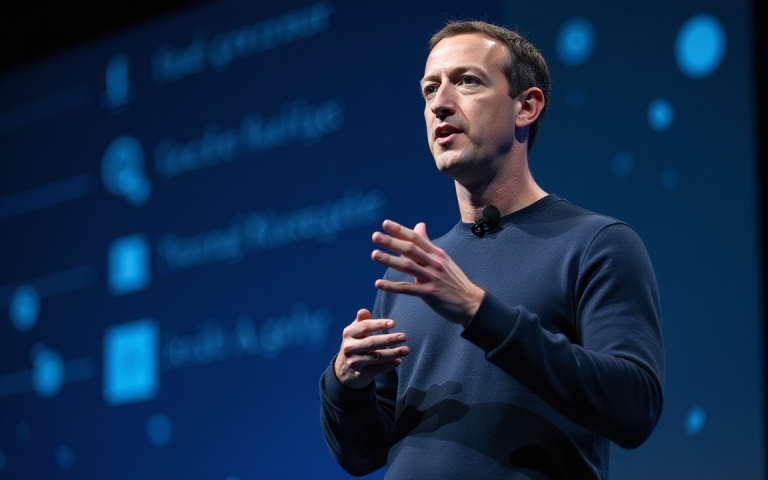Meta Platforms Inc. (NASDAQ:META) has always been a company of adaptation and innovation.
But its new defining moment doesn’t have to do with social media, the metaverse, or advertising dominance.
It’s about a singular obsession with AI.
Its CEO, Mark Zuckerberg, appears restless and more involved than ever.
After a year of missed model deadlines, public credibility gaps, and internal talent losses, he is now going all in.
The company is spending up to $72 billion on AI and infrastructure this year alone.
But critics and investors are now wondering if Meta is actually ahead, or if it is moving too fast without a solid foundation.
What’s going on with Llama 4?
Meta’s largest AI project to date is the Llama 4 family of models.
The flagship version, known as Behemoth, is built with two trillion parameters and is supposed to represent a leap in capabilities.
But it’s still not ready. The model missed its initial April launch, then missed an internal June deadline, and is now delayed again without a firm timeline.
What Meta has released are two smaller models, Maverick and Scout.
Both are natively multimodal, meaning they can process text, images, and other types of data.
They are available to developers and are powering some of Meta’s chatbot services across Facebook, WhatsApp, and Instagram.
Meta also adopted a Mixture of Experts architecture, which improves performance efficiency by activating only parts of the model as needed.
Internally, though, things are not looking good. Engineers say Behemoth doesn’t meaningfully outperform Llama 3.
Meta submitted a version of the model to a public leaderboard that wasn’t the same one released to users.
Critics said the company should have been clearer, and developers questioned the value of Meta’s benchmarks.
The credibility hit was significant. Eleven of the fourteen researchers who developed the original Llama model have left the company.
According to sources inside Meta, management is now considering changes to the AI division’s leadership.
Meta’s plan to automate everything
As technical development continues, Meta is also changing how it governs risk.
According to NPR, the company is now using AI to automate up to 90% of all internal reviews.
This includes reviews for privacy, misinformation, hate speech, and youth safety.
What used to require sign-off from human analysts is now decided by internal tools and questionnaires that engineers complete themselves.
Product teams can now get instant decisions from AI systems before launching updates. In most cases, they decide whether something qualifies for further human review.
Inside Meta, some see this as a way to move faster in a competitive environment. But former employees warn it creates blind spots.
One former director said that engineers are evaluated on shipping speed, not safety.
Another called the new process “self-defeating,” arguing that past scandals were often caused by overlooked risks that human teams could have caught.
The European Union may offer some buffer. Thanks to the Digital Services Act, Meta’s EU headquarters in Ireland will still oversee regional compliance.
But for the rest of the world, change is already underway.
Meta has also ended its US fact-checking program and loosened its policies on hate speech.
The company says this is about efficiency, while critics argue it’s a step back in platform accountability.
Why advertising may never look the same
Meta is also reshaping its advertising business. By the end of 2026, the company plans to fully automate the creation of ads using AI.
Advertisers will upload a product image, enter a budget, and Meta’s system will generate the entire campaign, from video and text to targeting and delivery.
This approach could open the door for millions of small businesses that don’t use ad agencies. But it also threatens large players in the industry.
Zuckerberg described the move as a redefinition of advertising. Meta’s ad business already brings in around $160 billion per year.
These new tools could make that number much bigger by lowering costs and simplifying access.
The company insists agencies still have a role, especially in managing complex campaigns.
But it’s clear the tools are built to cut them out for a large share of the market.
Why Meta wants to own the data too
As AI models grow in size and complexity, they require better data.
Meta is trying to secure that pipeline by investing more than $10 billion in Scale AI, a startup that labels and prepares data for model training.
It’s Meta’s biggest external AI investment so far.
Scale AI works with Microsoft, OpenAI, and the US Department of Defense.
It also partners with Meta on a project called Defense Llama, a version of Meta’s model designed for military use.
Scale’s founder, Alexandr Wang, is expected to join Meta’s new AI unit once the deal is complete.
The investment gives Meta a stake in the training infrastructure used by its competitors.
It also positions the company to expand further into government and defense contracts.
Last month, Meta signed a deal with defense contractor Anduril to build AI-enabled hardware for military applications, including augmented reality helmets.
Scale’s revenue is projected to double this year from $870 million to $2 billion.
The company was last valued at $14 billion in 2024, although that figure is expected to have doubled already.
Meta is using this partnership to secure long-term access to high-quality training data, a resource as important as compute power in the AI race.
Zuckerberg is going founder mode again
In response to missed goals and internal frustration, Zuckerberg is personally building a new elite group called the “superintelligence” team.
Its mission is to pursue artificial general intelligence, that is, AI that can perform as well as a human across a wide range of tasks.
The team will include around 50 people. Zuckerberg is directly recruiting them, meeting with candidates at his homes and even managing a WhatsApp group called “Recruiting Party.”
Some members of Meta’s existing AI staff are expected to join. Others are being hired from outside.
Zuckerberg says Meta doesn’t need outside funding to compete. He’s told recruits the company can finance a multi-gigawatt data center on ad revenue alone.
He’s also promising the freedom to build without the kind of investor pressure facing startups like OpenAI.
The project is separate from Meta’s existing AI divisions, which have faced criticism for delays and underperformance.
The superintelligence group is an attempt to reboot Meta’s AI efforts with speed, focus, and control.
Can Meta win the AI race?
Meta’s estimated $72 billion in AI spending places it behind Amazon, Microsoft, and Google in terms of raw capital.
But unlike its rivals, Meta doesn’t operate a cloud business. It can’t recycle infrastructure costs by selling compute to others.
Every dollar it spends must earn a return inside its own ecosystem.
To make that math work, Meta is betting on three things.
It’s betting that Llama, its open-source model family, can become the standard for developers.
It’s betting that AI-generated ads can grow its core business at a lower cost.
And it’s betting that its vast user base can absorb and normalize AI-driven products at a scale that few other companies can match.
But those bets require precision. And right now, Meta is doing everything at once.
It’s training massive new models, investing in training data providers, replacing human review systems with algorithms, building defense tech, and chasing AGI, all in a single push.
The ambition is undeniable. But the risk is that speed is outpacing maturity, and if Meta fumbles execution or loses public trust again, its $72 billion may be remembered as another “money pit.”
The post Meta’s $72B AI gamble: visionary empire or another money pit? appeared first on Invezz

